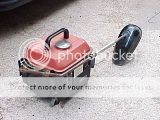bluenosegoat
New Member
So I've had a few people buying stock fuel tanks from me because theirs are leaking around the mounting studs. I would like to find a good way to fix them instead of trashing them. I've had very limited success with JB weld. I've learned that washing the tank with warm soapy water and then putting some dry ice in the tank as the co2 created will remove any fumes/oxygen which should make it safe to weld on? Just wondering if anyone out there has some experience welding fuel tanks. I am about to pick up some dry ice but I'm still pretty concerned about a fire or an explosion. Maybe its just worth replacing? Any safety precautions would be much appreciated.
I will be using a MIG welder if I get up the courage/stupidity. Thanks
I will be using a MIG welder if I get up the courage/stupidity. Thanks


